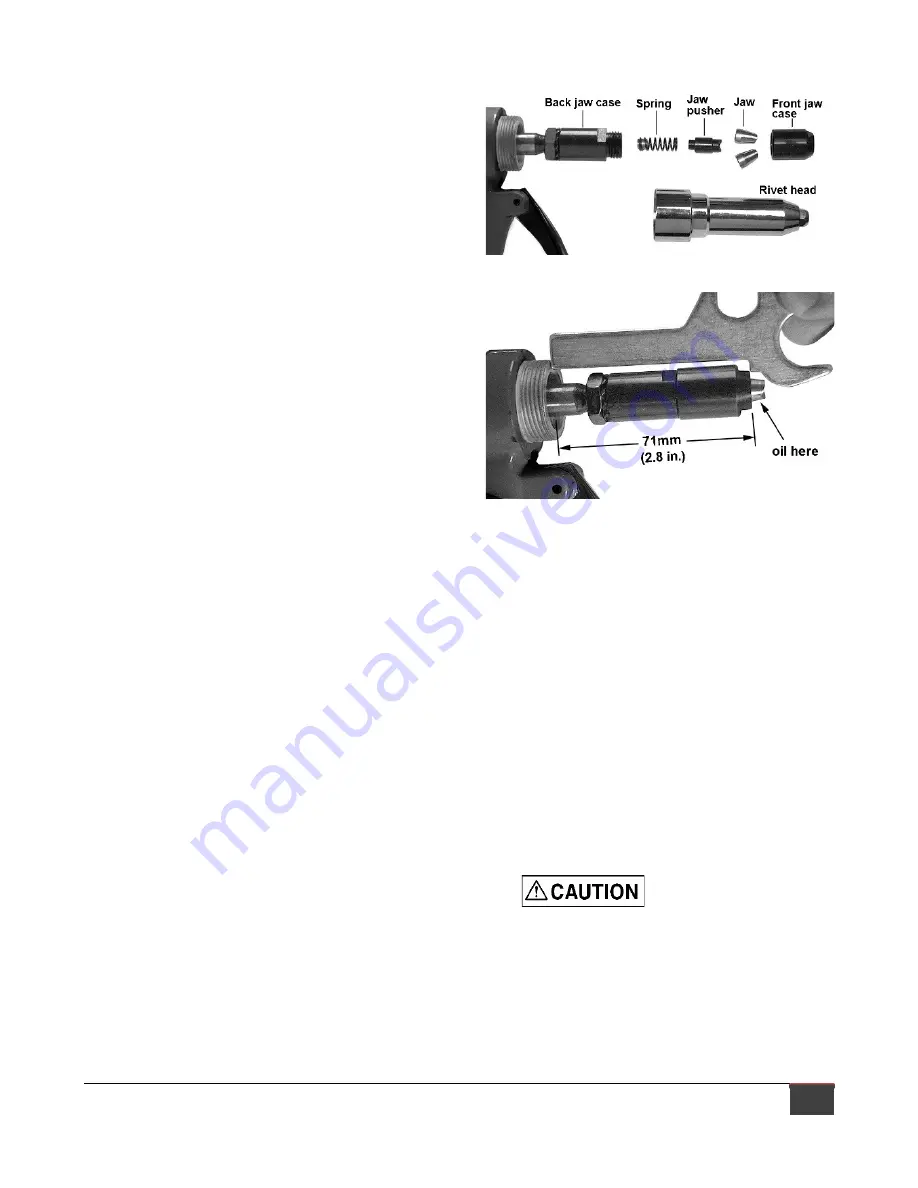
JET
7
Maintenance
Lubrication
The air riveter should be lubricated daily (or before
each use) with air tool oil through the air inlet.
During continual operation, it should be re-oiled
every 1 to 2 hours. This can be done with an in-
line oiler, or manually. If done manually, proceed
as follows:
1.
Disconnect air hose from tool.
2.
Place 4 or 5 drops of air tool oil into air inlet
(Figure 1).
NOTE: Air tool oil not provided; it is available
at most major hardware and tool stores. SAE
#10 oil or sewing machine oil may be used
as a substitute. Do not use detergent oil.
3.
Re-connect air. Fire riveter several times to
distribute the oil throughout tool.
4.
When finished operating riveter, disconnect
air hose. Wipe off housing with a dry cloth.
Place 4 or 5 drops of air tool oil into air inlet;
re-connect air and fire tool several times to
distribute the oil. Disconnect air.
Cleaning
The rivet head and jaw assembly should be
inspected, cleaned and lubricated as needed.
1.
Disconnect riveter from air supply.
2.
Loosen rivet head (Figure 3) with an
adjustable wrench (not provided), and
remove rivet head from nozzle.
3.
Use the provided gauge wrench to
disassembled jaw case, jaw halves, jaw
pusher and the spring.
4.
Clean each of the disassembled parts. Use
a cleaning brush on the internal threads of
the jaw and inside the rivet head.
5.
Reassembled parts in proper order.
6.
Use gauge wrench to check that length of
jaw assembly is correct (Figure 4). This
length ensures proper spring tension. Rotate
jaw assembly as needed until it fits the span
of the gauge as shown.
7.
Apply air tool to outside of jaw halves.
8.
Reinstall rivet head.
Figure 3
Figure 4
Storage
Avoid storing the air riveter in very humid locations
which promotes rusting of internal mechanisms.
Always oil the tool and disconnect air hose before
storage. A hanger is provided for suspending the
tool upright from a hook.
Air system requirements
1.
Use proper air hose size (refer to tool
specifications). The hose should be just long
enough to serve the working area. Excessive
hose length will cause pressure drop.
2.
Make sure air compressor supplies clean,
dry air at correct CFM for the tool.
3.
Set air pressure to 90 psi.
Excess air pressure
and/or unclean air will shorten the tool’s
life and may create a hazardous situation.
4.
Drain water from air compressor tank daily,
as well as any condensation from air lines.
Water in the air line may enter the tool and
cause damage.
5.
Change filters on the air system on a regular
basis.
Summary of Contents for JAT-920 505920
Page 9: ...JET 9 Figure 3 Recommended arrangement of air piping and air line system ...
Page 12: ...12 JAT 920 Pneumatic Riveter 505920 JAT 920 Pneumatic Riveter exploded view ...
Page 14: ...14 JAT 920 Pneumatic Riveter This page intentionally left blank ...


































